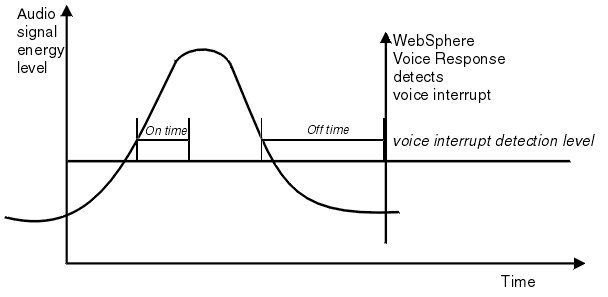Voice interrupt detection allows a caller to interrupt the playing of a prompt or a voice segment by speaking. Voice interrupt detection is controlled using three system parameters and four system variables. The system parameters specify default values for the whole system. These three parameters can be overridden for an individual application by the use of system variables. The other system variable turns voice interrupt detection on or off. This action cannot be done system-wide.
Table 1 shows the system variables and their equivalent system parameters:
| System Parameter |
System Variable |
|---|---|
| System : Voice Interrupt Detection On/Off (SV217) |
|
| Voice Interrupt Detection Level |
System : Voice Interrupt Detection Level (SV218) |
| Voice Interrupt Detection On Time |
System : Voice Interrupt Detection On Time (SV219) |
| Voice Interrupt Detection Off Time |
System : Voice Interrupt Detection Off Time (SV220) |
The value of Voice Interrupt Detection Level specifies the minimum energy level that the voice interrupt detector considers to be an interrupt. That is, any noises below that level do not count as interrupts.
Be careful when setting the Voice Interrupt Detection Level. If it is too high, the caller cannot interrupt prompts by speaking normally or shouting. If the value is too low, the echo1 from a prompt that is being played, combined with the background noise level from the caller's telephone, might interrupt prompts unintentionally. If a very loud echo occurs on a particular line, the level should be increased.
The value of Voice Interrupt Detection On Time specifies the minimum length of time for which the audio signal must remain above the minimum energy level. That is, a very short sound does not count as an interrupt.

After detecting a sound that qualifies as an interrupt (it is above the minimum energy level and longer than the minimum on time) the detector must ensure that the caller has finished speaking the word before it starts the next state table action. This is because the caller might have spoken a multi-syllable word as the interrupt; for example, "cancel". If the detector stops when it has heard the first syllable, the second syllable might be taken as another word and sent to a speech recognizer. (A tone played between the play and record actions in the state table ensures that the caller's interrupt completes before the record action begins.) So, the Voice Interrupt Detection Off Time value is used to ensure that a period of silence occurs after the interrupt-word has been spoken. This also ensures that a continuous sound picked up by the caller's telephone is not assumed to be an interrupt.
Default values exist for all of these parameters and variables, which work in most circumstances. Change these values only if you need to; for example, if levels are set too high or too low for the environments in which your applications are used. See the Blueworx Voice Response for AIX: Problem Determination information for examples of problems you might fine using voice interrupt detection and suggested solutions.
More information about voice interrupt detection is given in the Blueworx Voice Response for AIX: Designing and Managing State Table Applications information.